Articles
- Page Path
- HOME > Korean J Community Nutr > Volume 19(4); 2014 > Article
-
Research Article
- A Study on Food Habits and Nutrient Intakes according to BMI in Food and Nutrition Major and Non-major Female Students in Kyungnam University
- Eun-Hee Seo
-
Korean Journal of Community Nutrition 2014;19(4):297-316.
DOI: https://doi.org/10.5720/kjcn.2014.19.4.297
Published online: August 31, 2014
Department of Food and Nutrition, Kyungnam University, Changwon, Korea.
- Corresponding author: Eunhee Seo. Department of Food and Nutrition, Kyungnam University, Changwon 631-701, Korea. Tel: (055) 249-2233, Fax: (0505) 986-2184, muhyangse@kyungnam.ac.kr
Copyright © 2014 The Korean Society of Community Nutrition
This is an Open-Access article distributed under the terms of the Creative Commons Attribution Non-Commercial License (http://creativecommons.org/licenses/by-nc/3.0/) which permits unrestricted non-commercial use, distribution, and reproduction in any medium, provided the original work is properly cited.
- 855 Views
- 2 Download
- 8 Crossref
Abstract
-
Objectives
- This study was performed to investigate the body image, food habits, nutrition knowledge, food intake frequency, nutrient intakes of female university students in Masan.
-
Methods
- Two groups (n = 302, nutrition major: 147, non-major: 155) were classified into underweight, normal weight and overweight/obesity groups according to BMI respectively.
-
Results
- Height and weight of all subjects were 161.5 cm, 53.2 kg and were 161.5 cm, 55.1 kg, 161.5 cm, 51.3 kg in major and non-major female students, respectively. The BMI and body weight were significantly different (p < 0.001). Significantly higher proportions of underweight students in both study groups had perceived as 'normal' or 'fat' (p < 0.001). Higher proportion of the subjects skipped breakfast and main reason was no time to eat. Nutrition knowledge score was significantly higher in major than in non-major subjects (p < 0.001). Fish intake frequency score was significantly higher in non-majors, while the vegetable intake frequency score was significantly higher in majors. Nutrient intakes were significantly higher the majors compared to non-majors, particularly the intake of calcium (p < 0.05), zinc (p < 0.001), vitamin C (p < 0.001) and vitamin E (p < 0.01). Subjects in both groups did not have adequate nutrient intakes compared to KDRIs. BMI showed a positive correlation with body image, body weight and nutrition knowledge score (p < 0.01).
-
Conclusions
- These results suggest that systematic nutrition education program which can be applied in real life is important for the formation of correct choices of food and good eating habits.
- 1. Ahn BR, Park ES. Perception of body weight control, life styles, and dietary habits according to the obesity index (OI) offemale college students. J Korean Living Sci Assoc 2009; 18(1): 167-179.Article
- 2. Ahn Y, Kim H, Kim K. A study of weight control and associated factors among high school female students. Korean J Community Nutr 2005; 10(6): 814-824.
- 3. Bowman SA. Beverage choices of young females: changesand impact on nutrient intakes. J Am Diet Assoc 2002; 102(9): 1234-1239.PubMed
- 4. Burton S, Creyer EH, Kees J, Huggins K. Attacking the obesity epidemic: the potential health benefits of providing nutrition information in restaurants. Am J Public Health 2006; 96(9): 1669-1675.ArticlePubMedPMC
- 5. Cheong SH, Kwon W, Chang KJ. A comparative study on the dietary attitudes, dietary behaviors and diet qualities of food and nutrition major and non-major female university students. Korean J Community Nutr 2002; 7(3): 293-303.
- 6. Chin JH, Chang KJ. College student's attitude toward body weight control, health-related lifestyle and dietary behavior by self-perception on body image and obesity index. J Korean Soc Food Sci Nutr 2005; 34(10): 1559-1565.Article
- 7. Choi JH, Kim SK. Comparison of the dietary factors between normal and osteopenia groups by bone mineral density in Korean female college students. J Korean Soc Food Sci Nutr 2008; 37(7): 869-878.Article
- 8. Choi KS, Shin KO, Chung KH. Comparison of the dietary pattern, nutrient intakes, and blood parameters according to body mass index (BMI) of college women in Seoul area. J Korean Soc Food Sci Nutr 2008; 37(12): 1589-1598.Article
- 9. Choi MS, Choi DJ. A study on dietary attitudes, food behaviors and nutrition knowledge of food and nutrition majorand non-major female students. Korean J Food Nutr 1999; 12(3): 306-311.
- 10. Choi SH. A study of correlation among eating habit, health habit, and nutrition education of female university students with normal weight. Gyeongsang National University; 2013; 10-40 MS thesis.
- 11. Choi YS, Yoo YJ, Kim JG, Nam SM, Jung ME, Chung CK. Food preferences and nutrient intakes of college students in Kangwon province. J Korean Soc Food Sci Nutr 2001; 30(1): 175-182.
- 12. Cho JY, Song JC. Dietary behavior, health status, and perceived stress of university students. Korean J Food Nutr 2007; 20(4): 476-486.
- 13. Cho YJ. The comparative study on perception and satisfaction of somatotype of university woman students. J Korean Home Econ Assoc 2003; 41(11): 73-80.
- 14. Chung CE. Ready-to-eat cereal consumption enhances milk and calcium intake in Korean population from 2001 KoreanNational Health and Nutrition Survey. Korean J Nutr 2006; 39(8): 786-794.
- 15. Chung KH, Shin KO, Jung TH, Choi KS, Jeon WM, Chung DK, Lee DS. Study on the dietary habit, nutrient intake, and health status according to their majors among college women inSahmyook university. J Korean Soc Food Sci Nutr 2010; 39(6): 826-836.Article
- 16. Chung SH, Chang KJ. A comparison between food and nutrition major, and non-major female university students in terms of their nutrient intakes and hematological status with an emphasis on serum iron. Korean J Nutr 2002; 35(9): 952-961.
- 17. Fenton TR, Lyon AW. Milk and acid-base balance: proposed hypothesis versus scientific evidence. J Am Coll Nutr 2011; 30: 5 Suppl 1. 471S-475S.ArticlePubMed
- 18. Her ES, Kang HJ, Lee KH. The factors associated with weight control experiences among adolescents: based on self-esteem, body-cathexis, attitudes toward the body, anthropometric characteristics and perceptions of body shape. Korean J Community Nutr 2003; 8(5): 658-666.
- 19. Hong MS, Pak HO, Sohn CY. A study on food behaviors and nutrient intakes according to body mass index and body image recognition in female university students from Incheon. Korean J Food Nutr 2011; 24(3): 386-395.Article
- 20. Hong MS, Pak HO, Sohn CY. Comparative study of food behaviors and nutrients intake according to the bone mineral density of female university students. Korean J Food Nutr 2012; 25(1): 156-162.Article
- 21. Hwang JH, Lee HM. A study on lifestyles, dietary habits, nutrition knowledge and dietary behaviors of male university students according to residence type. Korean J Community Nutr 2007; 12(4): 381-395.
- 22. Jang JH. Study on eating habits, knowledge of obesity and its stress in BMI of female college student. SeoKyoung University; 2013; 19. MS Thesis.
- 23. Jung YM, Chung KS, Lee SE. Comparison of health behavior, body composition and body image in college women by BMI (body mass index). J Korean Soc Health Educ Promot 2005; 22(1): 87-102.
- 24. Kang HJ, Byun KW. Effect of two-year course of food and nutrition on improving nutrition knowledge, dietary attitudes and food habits of junior college female students. Korean J Community Nutr 2010; 15(6): 750-759.
- 25. Kim BR. A study on nutrition knowledge, dietary habits, health-related life style and health condition of college students in Chuncheon. J Korean Soc Food Sci Nutr 2006; 35(9): 1215-1223.Article
- 26. Kim HK. Effect of nutrition course on food habits and nutrition knowledge of college students. J Hum Ecol 1999; 1(2): 15-30.
- 27. Kim HS, Lee EY, Kim K, Kim KW, Pyun J, Chung SJ, Kwon YH, Yeo I, Lee S, Nam K. Survey on dietary behaviors and intakes of instant noodle (Ramyeon) soup among college students. Korean J Community Nutr 2013; 18(4): 365-371.Article
- 28. Kim HK, Kim JH. Food habits and nutrition knowledge of college students residing in the dormitory in Ulsan area. J Korean Soc Food Sci Nutr 2005; 34(9): 1388-1397.Article
- 29. Kim JN, Seo JH. A study on the life style and bone mineral density of women college students by body mass index. Food Ind Nutr 2004; 9(2): 41-45.
- 30. Kim JY, Son SJ, Lee JE, Kim JH, Jung IK. The effects of body image satisfaction on obesity stress, weight control attitudes, and eating disorders among female junior high school students. J Korean Home Econ Assoc 2009; 47(4): 49-59.
- 31. Kim KH. A study of the dietary habits, the nutritional knowledge and the consumption patterns of convenience foods of university students in the Gwangju area. Korean J Community Nutr 2003; 8(2): 181-191.
- 32. Kim KW, Shin EM. A study on nutrition knowledge, nutritional attitudes, dietary behavior and dietary intake by weight control attempt among middle school female students. Korean J Community Nutr 2002; 7(1): 23-31.
- 33. Kim MH, Lee YS. A study on the nutrient intake and food habits of college students in Chung-nam area. Korean J Community Living Sci 2006; 17(3): 143-158.
- 34. Kim MJ, Jun HY, Rha HB. Comparison of serum adiponectin levels according to body mass index and dietary behaviors of female university students in Seoul. Korean J Community Nutr 2013; 18(4): 354-364.Article
- 35. Kim MS. Eating behavior of university students by economic environment. Korean J Food Cookery Sci 2005; 21(2): 125-138.
- 36. Kim SH. A survey on dietary behaviors and liquid consumptions of university students in Kongju of Chungnam province in Korea. Korean J Nutr 2009; 42(4): 327-337.Article
- 37. Kim SY, Lee HM, Song KH. Body image recognition and dietary behaviors of college students according to the body mass index. Korean J Community Nutr 2007; 12(1): 3-12.
- 38. Kim UK, Nam HW, Park YS, Myung CO, Lee KW. Nutrition across the life span. Daejeon: Shinkwang; 2002. p. 53.
- 39. Kwak HK, Lee MY, Kim MJ. Comparisons of body image perception, health related lifestyle and dietary behavior based on the self-rated health of university students in Seoul. Korean J Community Nutr 2011; 16(6): 672-682.Article
- 40. Lim MY, Nam YS, Kim SS, Chang NS. Vitamin B status and serum homocysteine levels in infertile women. Korean J Nutr 2004; 37(2): 115-122.
- 41. Ministry of Health and Welfare, Korea Centers for Disease Control and Prevention. Korea Health Statistics 2010: Korea National Health and Nutrition Examination Survey (KNHANES V-1). Cheongwon: Korea Centers for Disease Control and Prevention; 2011.
- 42. Ministry of Health and Welfare, Korea Centers for Disease Control and Prevention. Korea Health Statistics 2009: Korea National Health and Nutrition Examination Survey (KNHANES IV-3). Cheongwon: Korea Centers for Disease Control and Prevention; 2010.
- 43. Nam HJ, Kim YS. The relationship between risk of eating disorder and severity of state-trait anxiety. Korean J Food Nutr 2005; 18(3): 229-240.
- 44. Park E, Cheong HS, Shin DS. A study on health condition and nutritional status of female university students in Masan area. J Korean Soc Food Sci Nutr 2004; 33(9): 1501-1514.Article
- 45. Park ES. A study of the body weight perception, living habits and food intake frequency by residence type in female college students of Chenbuk area. Korean J Hum Ecol 2013; 22(1): 215-230.Article
- 46. Park KA. Dietary habits, body weight satisfaction and eating disorders according to the body mass index of female university students in Kyungnam province. J East Asian Soc Diet Life 2009; 19(6): 891-908.
- 47. Park MS, Kim SA. Effect of nutrition education on improving diet behavior of university students. Korean J Community Nutr 2005; 10(2): 189-195.
- 48. Rhee JH. A study on effects of somatotypes and stress on body cathexis and preferences of clothing image. Res J Costume Cult 2007; 15(6): 1084-1099.Article
- 49. Rierdan J, Koff E. Weight, weight-related aspects of body image, and depression in early adolescent girls. Adolescence 1997; 32(127): 615-624.PubMed
- 50. Shin KO, Chung KH. Comparative study of dietary habits, mini dietary assessment scores, and health interest between female students in the department of food and nutrition and other departments, Sahmyook university. J East Asian Soc Diet Life 2010; 20(3): 341-351.
- 51. Shin YJ, Park GS. A study on eating habits of businessmen in urban areas. Korean J Diet Cult 1995; 10(5): 435-442.
- 52. Song WO, Chun OK, Obayashi S, Cho S, Chung CE. Is consumption of breakfast associated with body mass index in US adults? J Am Diet Assoc 2005; 105(9): 1373-1382.ArticlePubMed
- 53. Sung MJ, Chang KJ. Correlations among life stress, dietary behaviors and food choice of college students. J East Asian Soc Diet Life 2006; 16(6): 655-662.
- 54. The Korean Nutrition Society. Dietary Reference Intakes for the Koreans. Seoul: The Korean Nutrition Society; 2010.
- 55. Wang SG, Koo NS. A study on the foods and nutrient intake of college students. Nat Sci 1994; 5: 139-154.
- 56. World Health Organization. Obesity. Preventing and Managing the Global Endemic. WHO Technical Report Series no 894. Geneva: WHO; 2000; http://www.wpro.who.int/nutrition/documents/docs/Redefiningobesity.pdf.
- 57. Yeon JY, Hong SH, Bae YJ. A study on nutritional status and dietary quality of university students by body image. Korean J Community Nutr 2012; 17(5): 543-554.Article
- 58. Yoon HJ. A study on female college students' recognition on obesity and countermeasure. Sookmyung Women's University; 2007; 3. MS Thesis.
- 59. Zhang Q, Ma G, Greenfield H, Zhu K, Du X, Foo LH, Hu X, Fraser DR. The association between dietary protein intake and bone mass accretion in pubertal girls with low calcium intakes. Br J Nutr 2010; 103(5): 714-723.ArticlePubMed
REFERENCES
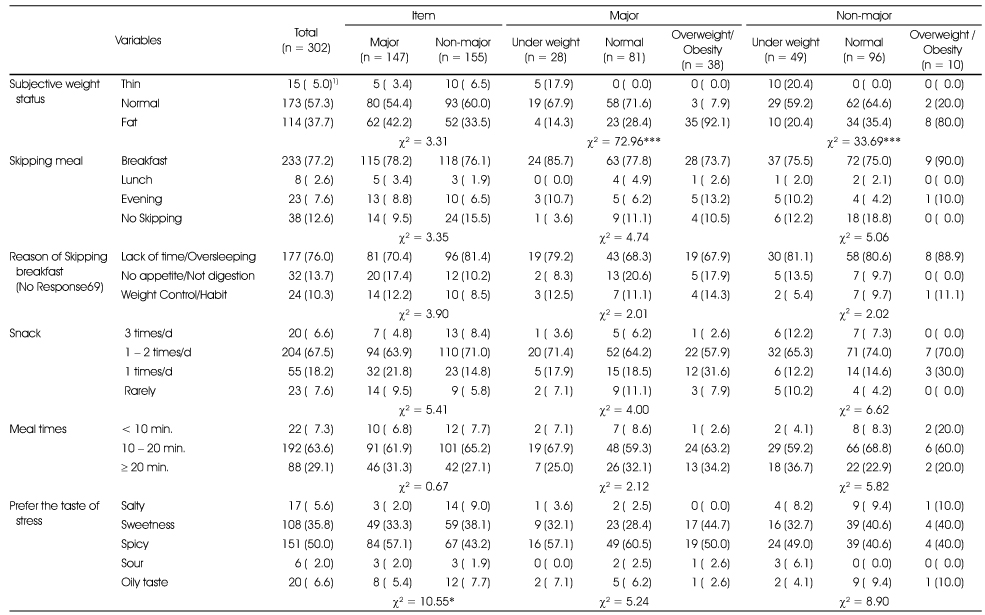
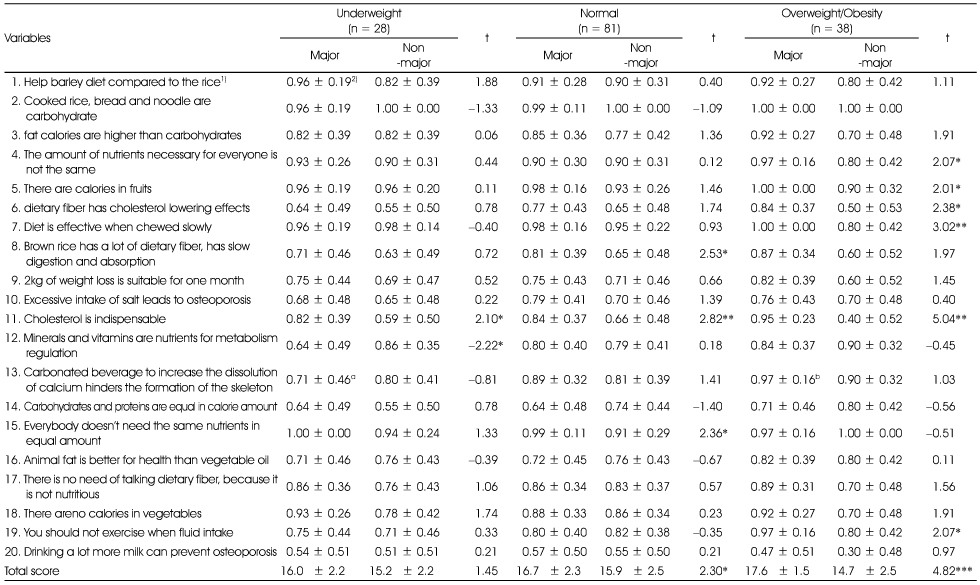
Figure & Data
REFERENCES
Citations

- Dietary life and mukbang- and cookbang-watching status of university students majoring in food and nutrition before and after COVID-19 outbreak
Hyunjoo Kang, Sowon Yun, Hongmie Lee
Journal of Nutrition and Health.2021; 54(1): 104. CrossRef - Relationship among the use of food-related content, dietary behaviors, and dietary self-efficacy of high school students in Seoul and Gyeonggi areas
Min-Hwan Oh, Kyungeui Hong, Sung-Eun Kim
Journal of Nutrition and Health.2019; 52(3): 297. CrossRef - Survey on Health Status and Food Habits of Male College Students in Wonju Area According to Drinking Behavior
Seung-Lim Lee
Journal of the Korean Dietetic Association.2016; 22(1): 41. CrossRef - Relationship between Eating Style and Food Intake of Healthy Female College Students during Chuseok Holidays
Seok-Young Kim
Korean Journal of Community Nutrition.2016; 21(2): 131. CrossRef - Health-related Factors, Nutrition Knowledge and Dietary Habits among Nursing and Allied Health College Students
Su Ol Kim
Journal of the Korean Society of School Health.2015; 28(3): 158. CrossRef - Nutrition Knowledge, Food Habit Problems and Dietary Attitudes of Nursing Students
Su-Ol Kim, So-Myeong Kim
The Journal of Korean Academic Society of Nursing Education.2015; 21(4): 466. CrossRef - Comparative Study on Knowledge of Food Habits and Perception of Beauty between Beauty & Fashion Major and Non-major Female College Students
Chae-Jeong Han
Journal of the East Asian Society of Dietary Life.2015; 25(6): 970. CrossRef - Survey on Health-related Factors, Nutrition Knowledge and Food Habits of College Students in Wonju Area
Seung Lim Lee, Sun Hee Lee
Korean Journal of Community Nutrition.2015; 20(2): 96. CrossRef
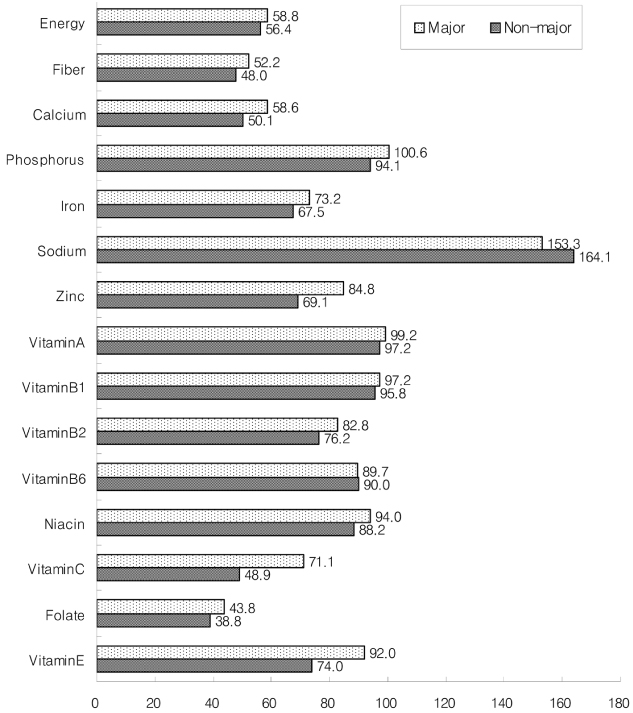
Fig. 1
Anthropometric assessment of the major and non-major female subjects by the BMI
1) Underweight: body mass index is less than 18.5
2) Normalweight: 18.5 ≤ body mass index < 23
3) Overweight/Obesity: body mass index ≥ 23
4) Mean ± SD
5) BMI: body mass index
***: p < 0.001 by t-test or ANOVA
a < b < c: Scheffe's multiple comparison
Subjective weight status and food habits of the major and non-major female subjects by the BMI
1) N (%)
*: p < 0.05, ***: p < 0.001 by χ2-test
The nutrition knowledge score of the major and non-major female subjects by the BMI
1) Each item was from 0 point (incorrect answer) to 1 point(correct answer)
2) Mean ± SD
*: p < 0.05, **: p < 0.01, ***: p < 0.001 by t-test or ANOVA
The differences in nutrition knowledge between major and non-major female subjects by the BMI
1) Each item was from 0 point (incorrect answer) to 1 point (correct answer)
2) Mean ± SD
*: p < 0.05, **: p < 0.01, ***: p < 0.001 by t-test
Food frequency of the major and non-major female subjects by the BMI
1) Mean ± SD
*: p < 0.05 by t-test or ANOVA
THe differences in food frequency between major and non-major female subjects by the BMI
1) Mean ± SD
*: p < 0.05 by t-test
Nutrient intakes of the major and non-major female subjects by the BMI
1) Mean ± SD
*: p < 0.05, **: p < 0.01, ***: p < 0.001 by t-test or ANOVA
The differences in nutrient intakes between major and non-major female subjects by BMI
1) Mean ± SD
*: p < 0.05, **: p < 0.01 by t-test
The correlation coefficients between the variables
*: p < 0.05 **: p < 0.01 by Pearson Correlation Analysis
1) Underweight: body mass index is less than 18.5 2) Normalweight: 18.5 ≤ body mass index < 23 3) Overweight/Obesity: body mass index ≥ 23 4) Mean ± SD 5) BMI: body mass index ***: p < 0.001 by t-test or ANOVA a < b < c: Scheffe's multiple comparison
1) N (%) *: p < 0.05, ***: p < 0.001 by χ2-test
1) Each item was from 0 point (incorrect answer) to 1 point(correct answer) 2) Mean ± SD *: p < 0.05, **: p < 0.01, ***: p < 0.001 by t-test or ANOVA
1) Each item was from 0 point (incorrect answer) to 1 point (correct answer) 2) Mean ± SD *: p < 0.05, **: p < 0.01, ***: p < 0.001 by t-test
1) Mean ± SD *: p < 0.05 by t-test or ANOVA
1) Mean ± SD *: p < 0.05 by t-test
1) Mean ± SD *: p < 0.05, **: p < 0.01, ***: p < 0.001 by t-test or ANOVA
1) Mean ± SD *: p < 0.05, **: p < 0.01 by t-test
*: p < 0.05 **: p < 0.01 by Pearson Correlation Analysis

 KSCN
KSCN


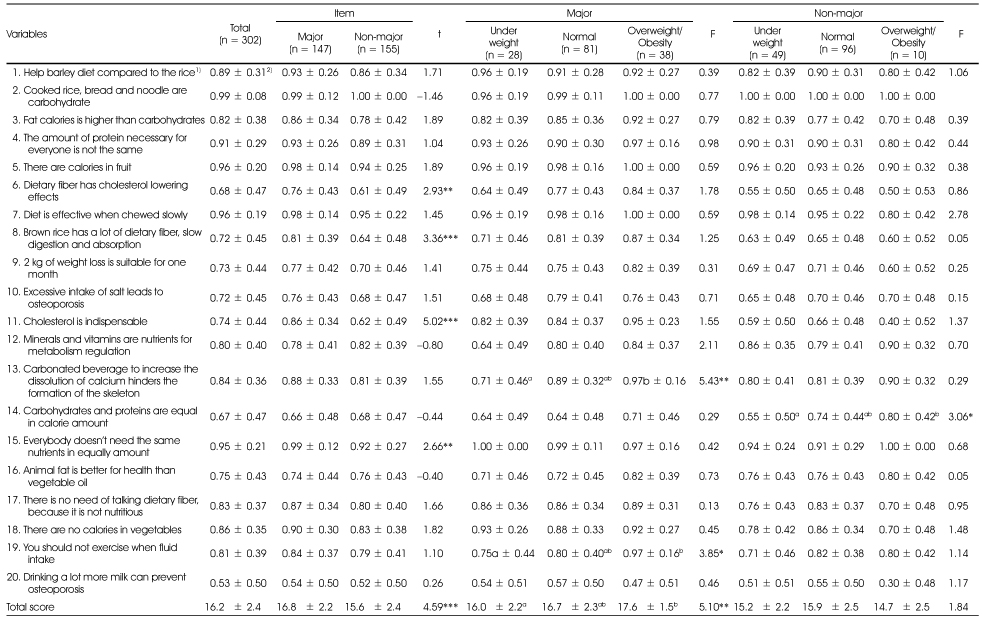



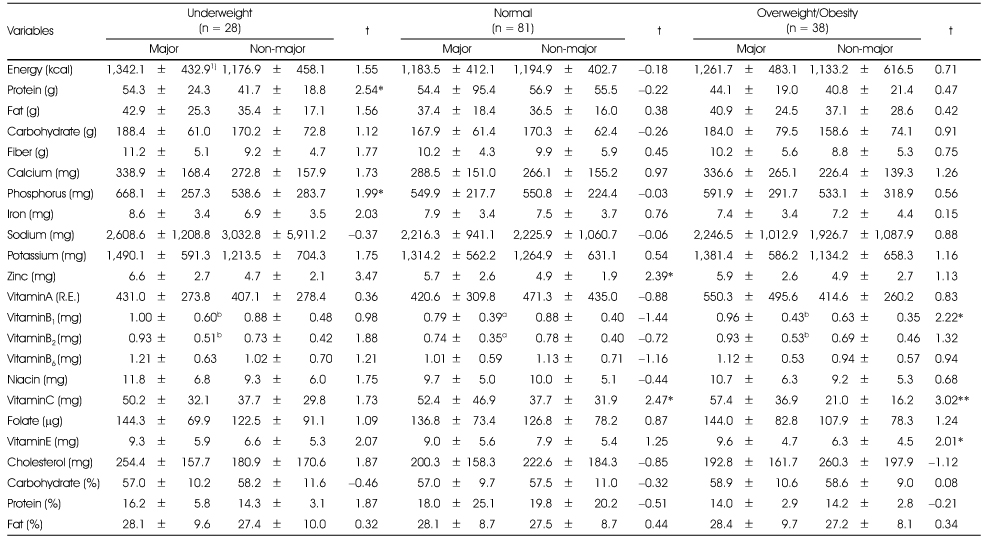

 PubReader
PubReader Cite
Cite


